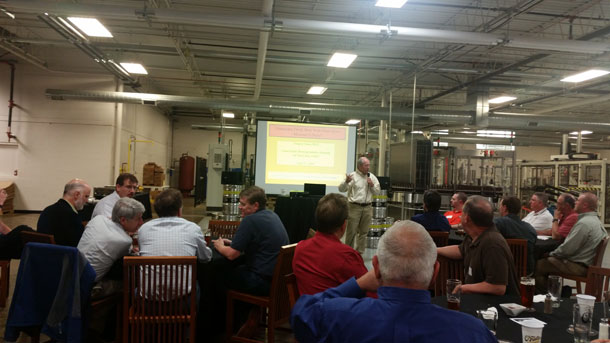Monroe babies in hallertau pic.twitter.com/JTmuCnwdZG
— Simply Hops (@SimplyHops) April 21, 2016
Yesterday I asked this question on Twitter: Which one of this is not a hop variety?
Ariana
Denali
Elvis
Monroe
Record
Sadly, voter turnout was low, but curiously the oldest variety here was the one selected most often as the invention and it took a while before Joshua David Hicks came up with the correct answer. Best I can tell, nobody has trademarked Elvis as the name of a hop variety.
I asked the question because this week a) Saint Arnold Brewing in Texas released a beer made with Ariana and has invited drinkers to provide feedback, and b) Sierra Nevada Brewing announced this year’s German Oktoberfest partner will be Mahrs Bräu and the beer will be made with the “nearly forgotten Record hop varietal.”
Saint Arnold calls its new beer Icon Green – 7220 Pale Ale, in part because the Germans only named the variety Ariana a few of weeks ago. German hop growers will be serving samples of beers made with this hop (its full name until last month was 2010/72/020) as well as 2010/08/033 next week at the Craft Brewers Conference in Philadelphia. Evaluating the hops raw members of a German panel found 2010/72/020 “pleasant and mild with slight nuances of berries like blackcurrant (cassis) and sweet fruits (peach, pear, tropical) and slightly resinous.” And they described 2010/08/033 as “hoppy, sweet fruit impressions like apricot and passion fruit. These are joined by one or two spicy and vegetable-like notes (bell peppers, olives).”
Texans who drink Icon Green can make up their own mind and provide feedback online. There are five essay questions:
– How would you describe the aroma of Hop 2010/72/20?
– How would you describe the taste of Hop 2010/72/20?
– Is there another hop you would describe as having a similar profile?
– For which beer styles would this hop be appropriate?
– What are your overall feelings toward this hop?
I can guarantee you German hop growers are looking forward to seeing the answers.
This is the second year that Sierra Nevada has collaborated with a Germany brewery to make an Oktoberfest beer. Last year’s partnership with Brauhaus Riegele resulted in one of my favorite Oktoberests of 2015. It was a malt forward beer, and the 2016 will be as well. So I’m not sure what mentioning the hop variety in the press release means. I’d like to know, and have already dashed off email enquiries, about why Record was chosen and where it is being grown now.
The variety resulted from breeding in Belgium — a Northern Brewer mother was open pollinated by a Saazer male — in the 1960s, intended to create a higher alpha hop that was relatively disease resistant. It was a high alpha hop in its day, about 6.2% alpha acids in 1981, and grown in what was then West Germany (almost 1,000 acres in 1978) as well as Belgium.
In case you are wondering, Denali is a variety from Hopsteiner first known as experimental variety No. 06277 (and unofficially as Nuggetzilla). Monroe is a relatively new hop from Germany (although its heritage is “American wild”) named after Marylin Monroe. The description from hop broker Barth-Haas suggests, “When you add the hop to a beer, then she shows her true colors: exactly like everyone remembers Marilyn Monroe in a red dress. A guise full of red aromas. In the nose, there are wonderful raspberry notes supplimented with orange syrup and added to this in the taste is the sweet taste that reminds one of summer and cherries.” I did not experience that at the 2015 Craft Brewers Conference when I had a beer brewed with Monroe, but I’ll seek out another sample next week at CBC in Philadelphia. Meanwhile, I am left wondering what we would expect a hop named Elvis to bring to a beer.
